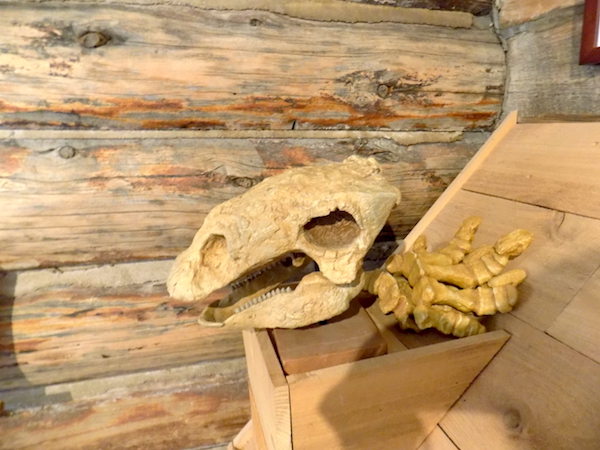
It sounds like one of the old “dinosaur in the jungle” movies, but the year is 1910 and there have been monster sightings in South Africa.

A Giant Dinosaur Still Alive?
A most circumstantial report of the existence of a monster, hitherto supposed to be extinct, has just been brought to civilization.
This creature bears a close resemblance to the famous brontosaurus of the scientific books, a gigantic reptile of lizard like form.
It is clearly possible that unknown monsters may still be in existence. In Africa a large animal, the okapi, until recently unknown, has been discovered, and in South America remains of the giant sloth have recently been found, indicating that these creatures lived in historical times, if not still existing.
It is also significant that Professor W.D. Matthew of the American Museum of Natural History of New York, in a statement printed elsewhere on this page, expressed his opinion that it is not impossible that some monsters commonly regarded as extinct may have survived.
The report of the existence of the new monster originated with Carl Hagenbeck of Hamburg, the most successful hunter and trainer of wild beasts in the world, and it has just received some remarkable additional confirmation.
In his newly published book, “Beasts and Men,” Hagenbeck, in a chapter describing his experiences in South Africa says:
“I received reports from two distinct sources of the existence of an immense and wholly unknown animal, said to inhabit the interior of Rhodesia. Almost identical stories reached me, first, through one of my own travelers, and, secondly, through an English gentleman who had been shooting big game in Central Africa.
“The reports were thus quite independent of each other, and, as a matter of fact, the Englishman and my traveler had made their way into Rhodesia from opposite directions, the one from the southwest. The natives, it seemed, had told both my informants that in the depth of the great swamps there dwelt a huge monster, half elephant, half dragon. This, however, is not the only evidence of the existence of the animal.
“It is now several decades since Menges, who is, of course, perfectly reliable, heard a precisely similar story from the negroes; and, still more remarkable, on the walls of certain caverns in Central Africa there are to be found actual drawings of this strange creature. From what I have heard of the animal, it seems to me that it can only be some kind of dinosaur, seemingly akin to the brontosaurus. As the stories come from so many different sources, and all tend to substantiate each other, I am almost convinced that some such reptile must be still in existence.
“At great expense, therefore, I sent out an expedition to find the monster, but, unfortunately, they were compelled to return home without having proved anything, either one way or the other. In the part of Africa where the animal is said to exist there are enormous swamps, hundreds of square miles in extent, and my travelers were laid low with very severe attacks of fever. Moreover, that region is infested with bloodthirsty savages, who repeatedly attacked the expedition and hindered its advance.
“Notwithstanding this failure, I have not relinquished the hope of being able to present science with indisputable evidence of the existence of the monster. And perhaps if I succeed in this enterprise naturalists all the world over will be roused to hit vigorously for other unknown animals; for if this prodigious dinosaur, which is supposed to have been extinct for hundreds of thousands of years be still in existence, what other wonders may not be brought to light?”
This statement was received with incredulity by scientists, and the zoologists of the Rhodesia Museum declared that nothing could be gathered from the natives respecting the alleged dinosaur.

The Bulawayo Chronicle, the principal newspaper of Bulawayo, the capital of Rhodesia, however immediately received more than one communication from its correspondents on the subject.
One correspondent states that he had found two natives, both of which affirm in the most positive manner that they themselves had seen the monster.
“Neither of the natives knew the other,” says the correspondent, but both were shown a number of sketches, some wholly imaginary and others constructed from illustrations of prehistoric reptiles, and both immediately picked one of the sketches as closely resembling the monster they had seen. Each, however, called the attention of the sketcher to the fact that he had omitted to give in his picture what from their description appeared to be propulsive flappers.
“According to the natives, the creature would seem to possess the head and tail of a crocodile, the horns of a rhinoceros, the neck of the python and the body of a hippopotamus.”
This description bears a considerable resemblance, after allowing for the mistakes of an uneducated observer, to the scientific accounts of the extinct brontosaurus.
The brontosaurus derives his name from two words, meaning “thunder” and “lizard.” This name was given because the scientists thought the monster must have made a noise like thunder when he walked.
The brontosaurus is a member of the order of dinosaurs, or monster reptiles, and belongs to the sub-order of sauropods or lizard footed dinosaurs. Hitherto the most extensive remains of dinosaurs and brontosauri have been found in America, principally in Kansas and Colorado and Wyoming.
The brontosaurus was one of the largest creatures that ever walked on land. It must always be remembered that none of these extinct monsters was as large as the existing whale. The brontosaurus was about sixty feet long and weighed about twenty tons.
It was a very stupid and slow moving creature, as indicated by the preposterously small size of its brain and the construction of its bones.
It was more or less amphibious in its habits, and Professor Marsh tells us that it fed upon aquatic plants and other succulent vegetation. Its remains are generally found in localities where the animal had become mired, just as cattle at the present day sometimes become fixed in a swampy place on the margin of a lake or river. Each track made by the creature in walking occupied one square yard in extent.
This description of the dwelling place of the brontosaurus corresponds with the region where the strange animal is reported to have been seen in South Africa.
A remarkably small head is one of the features of the brontosaurus and presents a curious contrast to the large and formidable skulls possessed by some other forms of dinosaurs.
It is clear that no animal with such a long neck as this creature — about twenty feet — could have borne the weight of a heavy skull. Short, thick necks and heavy skulls always go together. Indeed, the weight of the long neck would have been difficult to carry if it had not been for the fact that the vertebrae in this part of the skeleton have large cavities in their sides.
This cavernous structure of the vertebrae gradually decreases toward the tail, which must have been of enormous weight. The large cavities communicated with a series of smaller internal cavities, which give a honey combed structure to the whole vertebrae. The arrangements affords a combination of strength and lightness in the massive supports required for the huge ribs, limbs and muscles, such as could not have been provided by any other plan.
The body of the brontosaurus was comparatively short, with a very large paunch. The legs and feet were strong and massive, and the limb bones solid.
To balance the neck we find a long, powerful tail, in which the vertebrae are nearly all solid. In most dinosaurs the fore limbs are small compared to the hind limbs, but in the brontosaurus they are unusually large. This being the case, it is hardly likely that the creature walked upon its hind legs, as many of the dinosaurs did.
But we may conjecture that occasionally it assumed a more erect position. The light, hollowed structure of the vertebrae in the fore part of the body already alluded to would have aided the creature to assume such an attitude. He could have sat up on his hind legs and looked in at the window of a four story house.
The brontosaurus must have had some difficulty to survive in the struggle for existence with many large jawed, heavy toothed animals. He was not well equipped for attack.
We may suppose that when alarmed by dangerous flesh eating foes, he took to the water and found discretion to be the better part of valor. Although apparently stupid, the brontosaurus probably possessed a good deal of low cunning, and we can fancy him stretching his long neck above reeds, ferns and cycads to get a view of the approaching enemy.
After all, the greatest difficulty of the brontosaurus in its struggle for existence would have been to find enough vegetation to support the vast body, and it was probably for lack of nourishment that it ceased to exist.
It is conceivable that in the vast swamps in the interior of Rhodesia some of these creatures may have survived to the present day. In these swamps they would find a refuge from lions, leopards and other fierce carnivorous animals, who could not follow them into the mud and water.
The brontosaurus was very similar to diplodocus, of which Andrew Carnegie has presented the largest known fossil specimen to the Paris Museum of Natural History.
The carnivorous ceratosaurs, the horned arsinoitherium and the armored maosaurus are other extinct monsters possessing points of semblance to the creature reported by the South African natives.
How much weight can be given to the testimony of the native observers in Rhodesia? According to many explorers, the natives never invent a story entirely, and their statements are largely truthful. Carl Hagenbeck gives this very reasonable defense of the credulity of his native informers:
“I may suitably terminate this chapter by stating my opinion that science is in all probability still incompletely acquainted even with the larger members of the world’s fauna. My travelers explore the most remote parts of every continent, and it is therefore natural that they should often bring back information which is of great interest to zoologists. They often hear stories from the natives concerning strange animals, which, from the descriptions given, would appear to be unknown to Europeans.
“It might be supposed that these are mere cock and bull stories, either exaggerated descriptions of well known animals, or else intentional fabrications. But such is not usually the case. Much more often, the information given by the natives will lead to the discovery of new species, if the instructions of the natives be properly carried out. For instance, the case of the discovery of the remains of the giant sloth in South America is famous, and all my readers will remember the excitement which was caused when the existence of the okapi was made known. Native reports are more reliable than is commonly supposed.”
Source: The Spokane Press. Newspaper. January 16, 1910.

